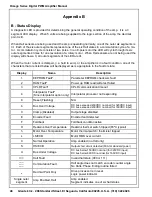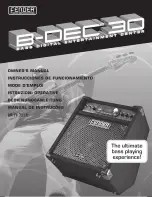
Glentek Inc. 208 Standard Street, El Segundo, California 90245, U.S.A. (310) 322-3026
61
cies <20 kHz. RF applications must be terminated with the shield at both ends, and possibly
at intermediate points for exceptionally long cables.
•
When shielded cables are not terminated at the cable connection and pass through the wall of
a cabinet, the shield must be bonded to the cabinet wall to prevent noise acquired inside the
cabinet from radiating outside the cabinet, and vice versa.
•
When shielded cables are terminated to connectors, the shield must be able to provide com-
plete 360
0
coverage and terminate through the connector backshell. The shield must
not
be
grounded inside the connector through a drain wire. Grounding the shield inside the connec-
tor couples the noise on the shield to the signal conductors sharing the connector and virtually
guarantees failure to meet European EMC requirements.
•
The shield must be continuous. Each intermediate connector must continue the shield con-
nection through the backshell.
•
All cables, both power and signal should use twisted wire pairing.
The shield termination described above provides a coaxial type of configuration, which provides mag-
netic shielding, and the shield provides a return path for HF currents that are capacitively coupled from
the motor windings to the frame. If power frequency circulating currents are an issue, a 250 VAC ca-
pacitor should be used at one of the connections to block 50/60 Hz current while passing HF currents.
Use of a properly shielded motor cable is essential to meet European EMC requirements.
The following suggestions are recommended for all installations.
1. Motor cables must have a continuous shield and be terminated at both ends. The shield
must connect to the ground bus bar or drive chassis at the drive end, and the motor frame
at the motor end. Use of a properly shielded motor cable is essential to meet European
EMC requirements.
2. Signal cables (encoder, serial, and analog) should be routed away from the motor cable and
power wiring. Separate steel conduit can be used to provide shielding between the signal
and power wiring. Do not route signal and power wiring through common junctions or race-
ways.
3. Signal cables from other circuits should not pass within 300 mm (1 ft.) of the drive.
4. The length or parallel runs between other circuit cables and the motor or power cable
should be minimized. A rule of thumb is 300 mm (1 ft.) of separation for each 10 m (30 ft.)
of parallel run. The 300 mm (1 ft.) separation can be reduced if the parallel run is less than
1 m (3 ft.).
5.
Cable intersections should always occur at right angles to minimize magnetic coupling.
6.
The encoder mounted on the brushless servomotor should be connected to the amplifier
with a cable using multiple twisted wire pairs and an overall cable shield. Encoder cables
are offered in various lengths that have correct terminations.
Persistent EMI problems may require additional countermeasures. The following suggestions for sys-
tem modification may be attempted.
1. A ferrite toroid or “doughnut” around a signal cable may attenuate common mode noise, par-
ticularly RS-232 communication problems. However, a ferrite toroid will not help differential
mode noise. Differential mode noise requires twisted wire pairs.
Appendix G
Summary of Contents for Omega SMC9930
Page 73: ...Glentek Inc 208 Standard Street El Segundo California 90245 U S A 310 322 3026 73 Appendix K...
Page 75: ...Glentek Inc 208 Standard Street El Segundo California 90245 U S A 310 322 3026 75 Appendix K...
Page 77: ...Glentek Inc 208 Standard Street El Segundo California 90245 U S A 310 322 3026 77...















































